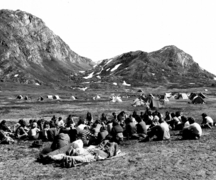Aasiviit
Political summer camps

In this way aasiviit were important forms of community, forging social, economic and cultural ties. They fostered alliances and the exchange of knowledge in areas like new resources and their use, weather conditions, animals to hunt, and their patterns of movement.
Greenlandic Inuit were used to travelling long distances before the advent of European colonisation, when the establishment of permanent trading stations brought an end to this extensive mobility. Previously the Inuit had travelled far to meet at aasiviit, where they traded goods. The journey to and from the aasiviit could take several years. The best-known aasiviit were Sermermiut in Ilulissat, Taseralik in Sisimiut, Kangeq in Nuuk, Uunartoq in Nanortalik, and Aluk in east Greenland. The choice of location was based on geographical position and resources in the area that were not to be found elsewhere.
As part of the rise in political consciousness of the 1970s, aasiviit were revived in a more modern form. Every year from 1976-96 the aasivik movement organised two-week cultural, spiritual and political summer rallies in different areas of Greenland. People at the rallies discussed current events, and after each rally issued resolutions with political statements to those in power. These often focused on Inuit cultural heritage at a broad level, with a specific focus on Inuit art, music and theatre. This work generated a renaissance in Inuit art, and was used politically with a range of social-realist and revolutionary content and expressive forms, sometimes with powerfully nationalist undertones. The qajaq had been dying out by the mid 1970s, but now became increasingly popular among young people as a sport. The same was true of drum and mask dances, which increasingly became part of modern Greenlandic music and theatre.
